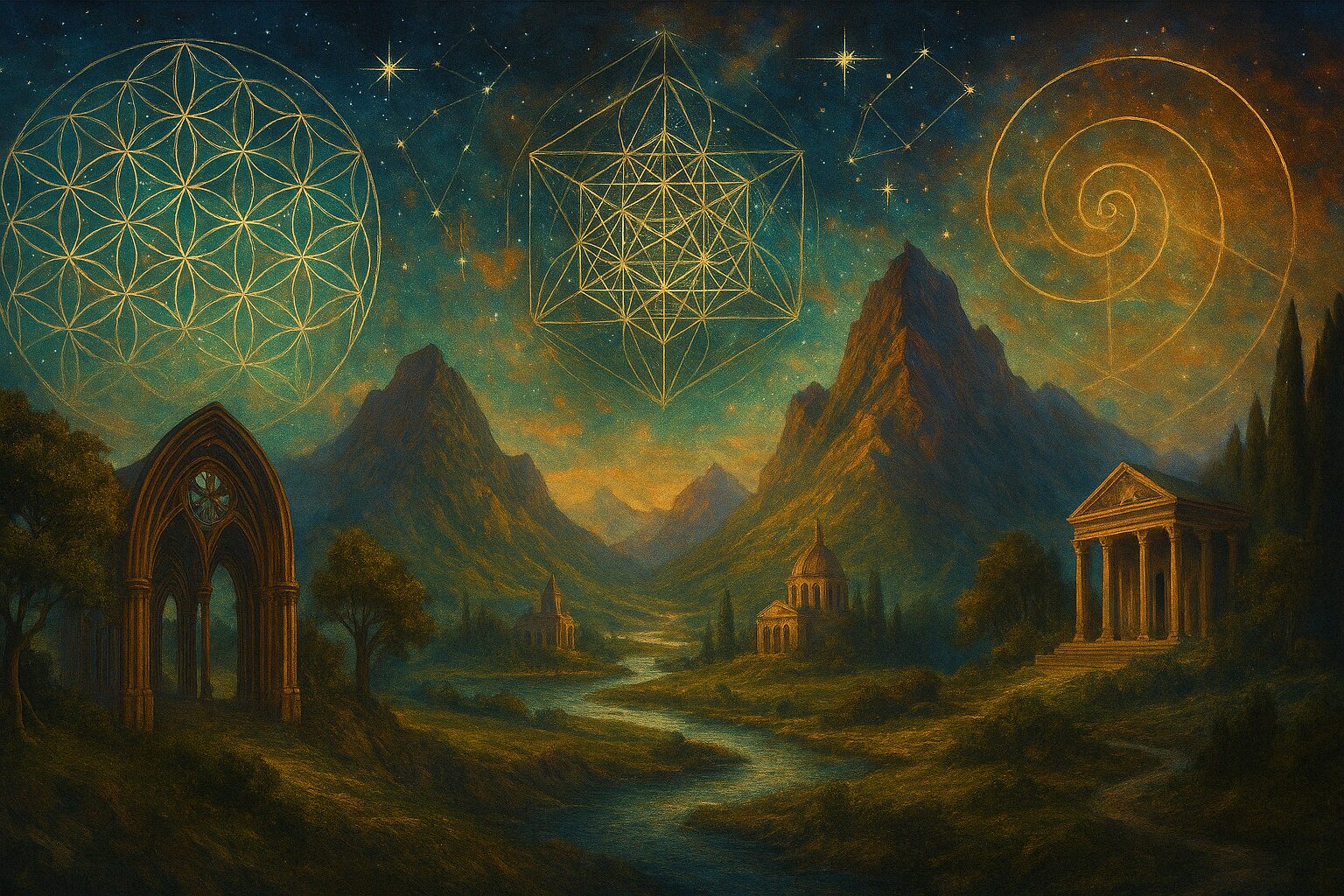“God geometrizes.” — Plato, Timaeus
Sacred geometry is a profound field of study that uncovers the hidden patterns of the universe and our connection to the divine. Throughout history, mystics, philosophers, and artists have used geometric symbols and shapes to express spiritual truths, explore the nature of reality, and create works that reflect divine harmony. Sacred geometry is not just about mathematical structures but about understanding how these shapes embody the underlying principles of creation itself.
The ancient Greeks saw geometry as a language through which one could communicate with the divine, and Plato, in his work Timaeus, famously stated, “God geometrizes.” This reflects the idea that the cosmos itself is built upon mathematical principles that are both transcendent and immanent. From the pyramids of Egypt to the architecture of Gothic cathedrals, sacred geometry has been used to manifest the divine order in the material world. Through its shapes and patterns, one can glimpse the structure of the cosmos, recognizing that the universe is not random but intricately designed.
The Geometry of Creation
Sacred geometry is based on several fundamental shapes, each of which holds profound symbolic meaning:
- Flower of Life: A pattern made up of multiple overlapping circles. This pattern is said to represent the interconnectedness of all life and the blueprint of creation. It is believed to contain the seed of all existence, embodying the potential for all things to emerge from a single, unified source.
- The Golden Ratio (Phi): The ratio approximately equal to 1.618, said to represent divine proportion and harmony. It can be found in nature, from the arrangement of leaves to the spirals of galaxies. The Parthenon in Athens and Leonardo da Vinci’s Vitruvian Man are examples of works that use this ratio to reflect the balance of the cosmos and the ideal human form.
- The Merkaba: A geometric form representing the divine chariot and the interplay of opposites, such as the masculine and feminine, the material and spiritual. This symbol is rooted in Kabbalistic thought, particularly in the concept of Tzimtzum — the divine contraction that created space for the world to manifest.
Sacred Geometry in Religious Architecture
One of the most striking uses of sacred geometry is found in religious architecture. The cathedrals of Europe, particularly during the Gothic period, are filled with intricate geometric designs meant to reflect divine order. Key examples include:
- Chartres Cathedral, France: The labyrinth on the floor is designed with sacred geometric precision, serving as a tool for meditation and spiritual pilgrimage. As pilgrims walk the labyrinth, they journey symbolically through the stages of spiritual enlightenment, reflecting inner self-discovery and transformation.
- Golden Ratio in Sacred Spaces: Many sacred buildings, such as cathedrals, use the golden ratio in their design. The precise proportions of sacred spaces are meant to harmonize with the spiritual dimensions of existence, fostering a connection between the human soul and the divine. This concept is mirrored in Vastu Shastra (Hinduism) and Feng Shui (Chinese tradition), both of which emphasize the alignment of physical spaces with cosmic principles.
The Flower of Life and Its Mystical Significance
The Flower of Life is one of the most iconic symbols in sacred geometry. This geometric figure consists of multiple evenly spaced, overlapping circles, creating a flower-like pattern. It is found in ancient temples, such as those in Egypt, and has been used by mystics throughout history to represent the unity of all life.
- Symbolism: The Flower of Life is said to contain the Seed of Life, the foundation of the creation of the universe. This symbol embodies the interconnectedness of all existence, reflecting divine unity.
- Kabbalah Connection: The interconnectedness in sacred geometry mirrors the teachings of Kabbalah. The Tree of Life, with its Sefirot (emanations of God), is often depicted using geometric patterns. The paths between the Sefirot represent the sacred order of creation and the descent of divine light.
Sacred Geometry in Art and the Mind
Sacred geometry also plays a crucial role in art. The creation of sacred spaces and objects — whether through paintings, sculptures, or architecture — aligns with the understanding that geometry is a tool for connecting with higher spiritual truths. Notable examples include:
- Michelangelo, Leonardo da Vinci, and Raphael: These artists employed sacred geometry in their works to convey divine harmony and balance. Da Vinci’s Vitruvian Man, for instance, uses the golden ratio to reflect the balance of the human form as a microcosm of the divine order.
- Divine Blueprint: Sacred geometry in art communicates the divine blueprint and creates works that resonate with a higher spiritual frequency. These patterns speak to the soul, reminding us of the hidden order that governs the universe.
Conclusion: The Divine Blueprint
In conclusion, sacred geometry is more than just a mathematical pursuit; it is a bridge to understanding the divine structure of the universe. The patterns and shapes that have been passed down through ancient texts and sacred traditions are not merely decorative; they are spiritual symbols that connect us to the sacred order of creation. By contemplating sacred geometry — whether through the study of symbols like the Flower of Life, the golden ratio, or the Tree of Life — we open ourselves to a deeper awareness of the interconnectedness of all existence.
As Plato wisely noted, “God geometrizes.” This simple truth reflects the idea that the cosmos is a living, breathing entity that communicates with us through its inherent mathematical harmony. By recognizing and aligning ourselves with these sacred patterns, we can cultivate a deeper understanding of the divine order and our place within it.
